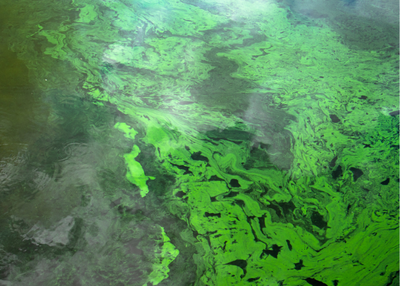Algal Blooms and Cyanotoxins: What You Need To Know
RSS
Analies Dyjak | Policy Nerd
Spring and summer are typically the seasons when algal blooms are most prevalent. When water temperatures rise and are accompanied by increased sunlight, it allows for higher rates of photosynthesis. This increased aquatic plant life can often lead to impairments in your drinking water. Here’s everything you need to know about algal blooms, cyanotoxins, and how to ensure your water is safe to drink.
What are Cyanotoxins?
Cyanobacteria naturally occurs in surface water. After an influx of nutrients or a sudden increase in water temperature, cyanobacteria can create Harmful Algal Blooms or HABs. HABs can then produce cyanotoxins, which are harmful to humans and the environment. Microcystins are the most widespread cyanotoxin in the United States, the most toxic being Microcystin-LR. Cyanotoxins are not currently federally regulated but the World Health Organization has provided an advisory level of 1 part per million for Microcystin-LR. Algal blooms and cyanotoxin production are extremely susceptible to changes in the surrounding environment. Toxicity levels can change within a matter of hours, making detection very difficult.
What are the Health Effects of Cyanotoxins in Drinking Water?
Acute exposure to cyanotoxins in drinking water can result in fevers, headaches, joint pain, stomach cramps and mouth ulcers and in severe cases, seizures, liver failure, and respiratory arrest. Studies have also found that long term exposure of low levels to microcystins can promote tumor growth, especially in the liver.
What Increases Levels of Cyanobacteria?
Anthropogenic factors are the predominant reason for an increased frequency and magnitude of cyanotoxin events. Nutrient loading from agricultural practices can cause algal blooms in both fresh and marine water, which also deoxygenates water systems.
How Do Harmful Algal Blooms Affect Water Treatment Facilities?
Municipal water treatment facilities generally do a good job of filtering out algae and cyanobacteria. They face problems when a large influx of algae clogs the filtration media. This can be costly to mitigate and challenging for municipalities if they lack proper equipment. Because cyanotoxins are not regulated, there’s a bit of a grey area as to whether municipalities are obligated to be looking for these contaminants.
As always, we encourage you to take advantage of Hydroviv's "Help No Matter What" technical support policy, where we answer questions related to cyanotoxins, drinking water and water filtration. Drop us a line at hello@hydroviv.com.
Other Articles We Think You Might Enjoy:Raw Water is Bad!
Bioaccumulation in Water Sources
Toldeo and Microcystin Exposure


